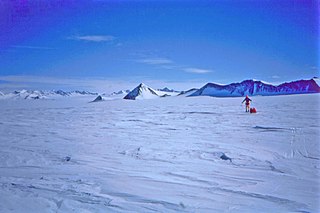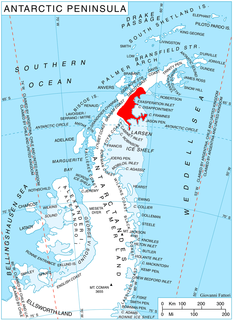Red Rock Ridge or Morro Roca Roja or Promontorio Roca Roja is a conspicuous reddish-colored ridge or promontory which rises to 690 m and projects from the west coast of Graham Land between Neny Fjord and Rymill Bay. Red Rock Ridge is located at 68°18′S67°08′W and has an elevation of 690 m. Red Rock Ridge was surveyed in 1936 by the British Graham Land Expedition (BGLE) under John Riddoch Rymill, who so named it because of its color. Further surveys in 1948 by the Falkland Islands Dependencies Survey (FIDS) have identified this ridge as the feature first sighted in 1909 and named "Île Pavie" or "Cap Pavie" by the French Antarctic Expedition under Jean-Baptiste Charcot, but the name Red Rock Ridge is now too firmly established to alter. The name Pavie Ridge has been assigned to the prominent rocky ridge at 68°34′S66°59′W.
Pavie Ridge or Cap Pavie or Île Pavie is a rocky ridge located at 68°34′S66°59′W in Antarctica which rises over 500 m. It extends south and west from Martin Glacier to Moraine Cove, and forms the southeastern limit of the Bertrand Ice Piedmont, on the west coast of Graham Land.
Hag Pike is a conspicuous rock column, 710 metres (2,330 ft) high, on the north side of the Wordie Ice Shelf near the west coast of the Antarctic Peninsula. Together with the mountain to the north, it forms the west side of the mouth of Hariot Glacier. Hag Pike was photographed from the air by the British Graham Land Expedition, 1937, and by the Ronne Antarctic Research Expedition, 1947. It was surveyed by the Falkland Islands Dependencies Survey, 1948–50, and 1958. The name by the UK Antarctic Place-Names Committee is descriptive, "hag" being the stump of a tree which remains after felling.
Cole Glacier is a glacier on the east side of Godfrey Upland, 11 nautical miles (20 km) long, flowing north-northeast into the Traffic Circle, in southern Graham Land. It was first seen by the United States Antarctic Service in 1940, but not named. It was roughly surveyed by the Falkland Islands Dependencies Survey in 1958, and named by the UK Antarctic Place-Names Committee after Humfray Cole, the most famous English instrument maker of Elizabethan times, who pioneered the design of portable navigation instruments and equipped Martin Frobisher's expeditions.

Weir Glacier is a glacier 8 nautical miles (15 km) long, flowing north into the south part of Barilari Bay between Prestoy Point and Byaga Point, on the west coast of Graham Land. First sighted and roughly charted in 1909 by the French Antarctic Expedition under Charcot. It was surveyed in 1935-36 by the British Graham Land Expedition (BGLE) under Rymill and later named for William D. Weir, 1st Viscount Weir of Eastwood, and his son, the Hon. James K. Weir, who contributed toward the cost of the BGLE, 1934-37.
Mount Gunter is a conspicuous mountain, 1,970 metres (6,460 ft) high, with precipitous black rock cliffs on its west side, rising at the south side of Hariot Glacier, 3 nautical miles (6 km) east of Briggs Peak, on the west side of the Antarctic Peninsula. It was first roughly surveyed by the British Graham Land Expedition in 1936–37, and was photographed by the Ronne Antarctic Research Expedition in November 1947. It was surveyed by the Falkland Islands Dependencies Survey in 1958, and was named by the UK Antarctic Place-Names Committee after Edmund Gunter, an English mathematician whose "line of numbers" (1617) was the first step toward a slide rule; in 1620 he published tables of logarithms, sines and tangents, which revolutionized navigation.
Trepassey Island is a small rocky island 0.6 nautical miles (1.1 km) southeast of Stonington Island in Neny Bay, off the west coast of Graham Land. Several islands were roughly charted in the area by the British Graham Land Expedition (BGLE), 1934–1937, and by the United States Antarctic Service (USAS), 1939-1941. They were surveyed in 1947 by the Falkland Islands Dependencies Survey (FIDS) and named for the M.V. Trepassey, ship used by the FIDS in establishing a base on Stonington Island in 1946.

Mount Paris is a conspicuous mountain, about 2,800 m, 4 nautical miles (7 km) southeast of Mount Bayonne situated in the northern portion of Alexander Island, Antarctica. The mountain was first mapped by the French Antarctic Expedition, 1908–10, under Charcot, who named it for the French capital, Paris. The mountain was resighted in 1936 by the British Graham Land Expedition (BGLE) and charted as mountains, but subsequent study of air photos taken by the Ronne Antarctic Research Expedition (RARE), 1947–48, has caused the name to be restricted to this single mountain. Mount Paris is the third-highest peak of Alexander Island, while Mount Egbert remains second standing at 2,850 m in height.
Fielding Col is an east-west trending pass between the Baudin Peaks and Hag Pike in southern Graham Land, Antarctica. It provides the best known route leading inland to Morgan Upland between Neny Fjord and the Wordie Ice Shelf. It was named by the UK Antarctic Place-Names Committee after Harold M. Fielding, a British Antarctic Survey surveyor at Stonington Island, 1967–69.
Gorev Island is a small island lying between Buromskiy Island and Poryadin Island in the Haswell Islands, Antarctica. It was discovered and mapped by the Australasian Antarctic Expedition under Mawson, 1911–14. It was remapped by the Soviet expedition of 1956, and named by them for Demetri Gorev, a member of the British Antarctic Expedition, 1910–13, under Robert Falcon Scott.
Meridian Glacier is a broad glacier, 9 nautical miles (17 km) long, which flows south along the west side of Godfrey Upland and joins Clarke Glacier between Behaim Peak and Elton Hill, in southern Graham Land, Antarctica. Finn Ronne and Carl R. Eklund of the United States Antarctic Service travelled along this glacier in January 1941. It was photographed from the air by the Ronne Antarctic Research Expedition in November 1947, and was surveyed by the Falkland Islands Dependencies Survey in December 1958. The glacier was so named by the UK Antarctic Place-Names Committee because the glacier flows from north to south along the meridian.
Hall Cliff is a sandstone cliff 1 nautical mile (2 km) long, located along the south side of Saturn Glacier and 1 nautical mile west of Citadel Bastion in eastern Alexander Island, Antarctica. The feature was mapped from trimetrogon air photography taken by the Ronne Antarctic Research Expedition, 1947–48, and from survey by the Falkland Islands Dependencies Survey, 1948–50. It was named by the UK Antarctic Place-Names Committee from association with Saturn Glacier after Asaph Hall, the American astronomer who contributed toward the study of Saturn and also discovered the satellites of the planet Mars.
Hare Peak is an ice-free peak, 2,970 metres (9,740 ft) high, at the north end of the ridge forming the east side of Leigh Hunt Glacier, in the Queen Maud Mountains of Antarctica. It was named by the New Zealand Geological Survey Antarctic Expedition (1961–62) for Clarence Hare, a member of the British National Antarctic Expedition (1901–04).

Lippert Peak is a sharp pointed peak at the end of a ridge that extends west from the Douglas Peaks into Horseshoe Valley, located 5 nautical miles (9 km) southeast of Strong Peak in the Heritage Range, Antarctica. It was mapped by the United States Geological Survey from surveys and U.S. Navy air photos from 1961–66, and was named by the Advisory Committee on Antarctic Names for George E. Lippert, a United States Antarctic Research Program biologist at Palmer Station in 1965.
Klevetind Peak is a peak, 2,910 metres (9,550 ft) high, immediately south of Klevekampen Mountain in the Filchner Mountains of Queen Maud Land, Antarctica. It was photographed from the air by the Third German Antarctic Expedition (1938–39), was mapped from surveys and air photos by the Sixth Norwegian Antarctic Expedition (1956–60) and named Klevetind.
Klakknabben Peak is a low isolated peak 2 nautical miles (4 km) northeast of Gavlpiggen Peak, just north of the Kirwan Escarpment in Queen Maud Land, Antarctica. It was mapped by Norwegian cartographers from surveys and air photos by Norwegian–British–Swedish Antarctic Expedition (1949–52) and from additional air photos (1958–59), and named Klakknabben.

Sleipnir Glacier is a glacier 10 nautical miles (18 km) long, flowing into the west side of Cabinet Inlet between Balder and Spur Points, on the east coast of Graham Land, Antarctica. Vologes Ridge is situated in the central portion of the glacier.
Hornet Peak is a sharp peak 3 nautical miles (6 km) west of Snøhetta Dome, near the south end of Ahlmann Ridge in Queen Maud Land, Antarctica. It was mapped by Norwegian cartographers from surveys and air photos by the Norwegian–British–Swedish Antarctic Expedition (1959–52) and from air photos by the Norwegian expedition (1958–59) and named Hornet. Confusingly, it is located only a few kilometres from its near-namesake, Horten Peak.
Ragged Peaks is a prominent group of peaks on the eastern side of Amundsen Bay in a line running almost north-south. The peaks, extending 8 nautical miles (15 km), contain several spires and the ridge connecting the peaks is much serrated. There are five peaks over 915 meters. They were sighted in October 1956 by the ANARE Amundsen Bay party led by P.W. Crohn. The descriptive name was given by the Antarctic Names Committee of Australia (ANCA).

Richthofen Pass is a pass, 1 nautical mile (1.9 km) wide, between Mount Fritsche and the rock wall north of McCarroll Peak, on the east coast of Graham Land. Discovered and photographed in 1902 by the Swedish Antarctic Expedition under Nordenskjold, who named it Richthofen Valley for Baron Ferdinand von Richthofen, German geographer and geologist. The feature was found to be a pass by the Falkland Islands Dependencies Survey (FIDS) in 1955.









